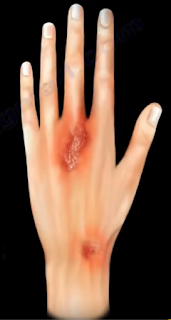Mycobacterium Marinum
Mycobacterium marinum is the most common atypical
mycobacterium that can cause infection in humans. It is found in salt and fresh
water. It is an acid-fast bacilli. The wrist and the hand are affected in about
50% of the cases. It may cause skin and soft tissue infections after skin
abrasion. The patients are exposed to aquatic environments such as aquariums
and swimming pools. The disease often occurs following the cleaning of fish
tanks. The bacilli enter the body through scratches and abrasions, causing
lesions in the tissue. The diagnosis is usually delayed because the condition
is rare, and the history of aquatic exposure is usually not obtained. The hand
and wrist are commonly involved. There will be painful swelling of the hand.
Subcutaneous granules, masses, nodules, ulcers, and noncaseating granulomas are
present. It may present as chronic tenosynovitis of the hand. It affects the
extensors more than the flexors. It can cause a TB like disease in fish. The
chronic skin lesion is sometimes called a “swimming pool granuloma” or “fish
tank granuloma” in humans. The bacteria grows in a low temperature culture at
30o centigrade. The bacteria grows on Lowenstein-Jensen medium. It
requires lower temperature and a longer period of the incubation (up to 6 weeks
or more). It can be treated with oral antibiotics antimicrobial therapy.
Ethambutol and Rifampin if diagnosed early. Minocycline and Clarithromycin has
been described. Surgery is done in late stages and in deep infection. Surgery
entails synovectomy and debridement in addition to oral antibiotics for
approximately 3 months. Mycobacterium avium-intracellulare occurs in terminal
AIDS patients, or it also can occur in a non HIV patient.
